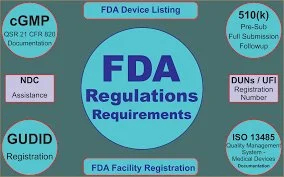The medical device industry is heavily regulated to ensure the safety and effectiveness of devices used in healthcare settings. Two key terms often encountered in this regulatory landscape are FDA device registration and FDA clearance. In this blog, we will delve into the nuances of FDA device registration and FDA clearance, shedding light on their differences and helping manufacturers and stakeholders gain a better understanding of these crucial processes.
I. The FDA and Medical Device Regulations
The Food and Drug Administration (FDA) is responsible for safeguarding public health by regulating medical devices sold in the United States. The FDA ensures that these devices meet rigorous standards for safety, efficacy, and quality. Manufacturers must navigate the FDA's regulatory pathways to bring their devices to market.

II. FDA Device Registration
a) Definition: FDA device registration is the process through which medical device establishments are registered with the FDA. This registration provides the FDA with information about the manufacturer, the devices they produce, and their intended use.
b) Purpose: Device registration enables the FDA to maintain an accurate and up-to-date database of medical device manufacturers and the devices they produce. It helps the FDA track devices, monitor safety concerns, and facilitate effective communication with manufacturers.
c) Requirements: Manufacturers must register their establishment with the FDA and provide information such as company details, device types, and classifications. This registration is required annually, or whenever there are significant changes in the establishment's operations.
III. FDA Clearance
a) Definition: FDA clearance is the process by which the FDA evaluates and approves certain medical devices before they can be marketed and sold in the United States. The FDA ensures that these devices are safe and effective for their intended use.
b) Purpose: FDA clearance is a critical step in the regulatory pathway for new medical devices. It ensures that devices meet the FDA's regulatory requirements and provides assurance to healthcare professionals and patients about their safety and effectiveness.
c) Requirements: Manufacturers seeking FDA clearance must submit a premarket notification, also known as a 510(k) submission. The 510(k) submission demonstrates that the new device is substantially equivalent to a legally marketed device (predicate device) and does not present any significant differences in safety and effectiveness.

IV. Key Differences: FDA Device Registration vs. FDA Clearance
a) Scope: FDA device registration applies to all medical device establishments, including manufacturers, distributors, and importers. FDA clearance, on the other hand, specifically pertains to the approval process for new medical devices.
b) Timing: Device registration is an ongoing requirement, with establishments updating their registration annually or when significant changes occur. FDA clearance, on the other hand, occurs prior to the marketing and sale of a new medical device.
c) Information Provided: Device registration primarily focuses on providing the FDA with establishment and device-related information. FDA clearance, however, requires a more comprehensive submission that includes detailed information on the device's safety and effectiveness in comparison to a predicate device.
d) Rigor of Review: Device registration is a straightforward administrative process, while FDA clearance involves a more rigorous evaluation by the FDA. Clearance requires the submission of a detailed 510(k) application, which undergoes a thorough review to determine substantial equivalence and compliance with regulatory requirements.
V. Other Regulatory Pathways
It's important to note that FDA clearance is not the only pathway for bringing a medical device to market. Certain devices may require a different regulatory pathway, such as a premarket approval (PMA) application for high-risk devices or a humanitarian device exemption (HDE) for devices designed to treat rare diseases.

VI. Conclusion
Understanding the distinctions between FDA device registration and FDA clearance is crucial for medical device manufacturers and stakeholders. Device registration ensures that the FDA has accurate information about establishments and their devices, while FDA clearance is the process by which new devices gain approval for marketing and sale. By navigating these regulatory pathways effectively, manufacturers can bring safe and effective medical devices to the market, benefiting healthcare professionals and patients alike.
Kingsmead was founded in 2012 and provides authorized representatives and consulting services for medical devices. Kingsmead team is composed of multiple medical device experts, proficient in the requirements of medical device regulations and medical device regulations.
If you need help with the FDA device registration,welcome to contact Kingsmead.We will provide you with professional help to ensure you receive specific guidance suitable for your device and circumstances.
E-mail:office@kingsmead-service.com

